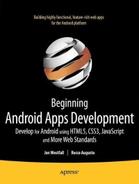Introduction
Both of the first author’s (Jon’s) parents were artists. They each could draw fantastical pictures that resembled real life, and were shocked to see that their son could barely muster up a stick figure. If you’ve always felt that your inner artist was best expressed through what you could build with the help of a computer and the Internet, then this book can guide your virtual paintbrush. The finished product? A mobile web application for Android devices, which can in turn inspire creativity and productivity in millions of prospective users. It is our hope that this book will give you all that you need to get up and running and creating your masterpieces in no time.
Who This Book Is For
This book is written at a beginner’s level. For the most part, we assume nothing as we write about everything from what HTML is to how to apply CSS to querying databases and displaying content using JavaScript. For some, this may mean that they would like to skim certain introductory materials (and assuredly miss many bad jokes). However, even advanced users will likely gain something from the tricks we unroll our sleeves to reveal.
How This Book Is Structured
We’ve split the content in this book into several chapters, with three “unofficial” parts.
In the first part, we introduce you (Chapter 1) to the basic languages of the web: HTML, CSS, JavaScript, and more. We then jump into two applications (Chapters 2–3) quickly to get your feet wet, and then back out to discuss planning concerns you might need to address when designing your own apps (Chapters 4–6)
In the second part, we start to jazz things up a bit. We go into building impressive user interfaces (Chapter 7) and working with visual content (Chapter 8). We then show you two more applications (Chapters 9–10) that speak to the unique nature of mobile applications: Using location information to guide your apps (and users), as well as tapping into the cloud for information and data.
Finally, in the last part, we talk about the next level of interactivity to add to your applications. We touch on adding audio and video (Chapter 11), doing things behind the user’s back to provide impressive functionality (Chapter 12) and wrapping it all up and uploading to the web or building a full app for your formerly browser-bound creation (Chapter 13).
While we’ve grouped chapters into a logical order, after Chapter 1 you should feel free to explore the rest of the content. While many topics build upon one another, reading what interests you first may help you get a good grasp of what concepts from earlier chapters you’ll definitely want to check out. At the same time, there are nuggets of information in each chapter that will stand upon their own, especially discussions on design, psychology, and user experience! We hope you enjoy the journey!
Downloading the code
The code for the examples shown in this book is available on GitHub at https://github.com/jonwestfall/Beginning-Android-Web-Apps-Development.
Contacting the Author
We’re always happy to hear from our readers, and if you have questions, comments, or thoughts about the book (or life in general), you can contact any of us through our personal websites or social media.
Jon Westfall: http://jonwestfall.com Twitter: @jonwestfall
Rocco Augusto: http://nerdofsteel.com/ Twitter: @therocco
Grant Allen: http://www.artifexdigital.com Twitter: @fuzzytwtr
